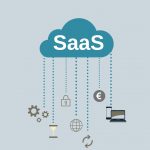Definition and Function
“Software as a service” (Saas) is a means of dematerializing software. The Publishers, or Providers, host the software applications and make them accessible to the customer via internet, similar to a service.
In more traditional ways of operating, the user buys the software and then installs it on his computer. With the SaaS model, the user subscribes to the software instead of buying it; this is sometimes also referred to as software rental.
Everything is done online. Server maintenance, data security, database backups, management of attached files and updates are done directly and externally by the service provider.
In order to undertake work, users simply need to have internet access and the relevant codes for the online service.
Advantages
There are many advantages to a SaaS. It’s a practical, fast and efficient solution.
Everything is accessible online, via internet
This means that not only is it it not necessary to have powerful servers, but also that the software is quickly accessible on any internet device through a simple web browser. So, there is no more software to install on users’ computers.
Some publishers offer responsive design solutions, which means that the display of the software web page automatically adjusts to the screen size of the device that it is being viewed on. Whether on smartphone, tablet or desktop computer, it is possible to use the software everywhere and anywhere, regardless of if it’s at the office or on the field.
Reduced costs
The Saas software is provided in a subscription format, which does not impact the investment capacity of the company and allows for a better budget control. Nor do you need to invest in new and powerful computer equipment for the company’s proper functioning.
Software is always updated
Updates are usually deployed automatically. As soon as an update is available, the provider makes it available online, often for free. This also ensures the scalability of the software solution.
A higher level of reliability and security
With a SaaS, the security level is usually higher than with an internal management system, as data centers are better protected against failures than on a local site.
The data is stored outside of the company which ensures, in case of breakdowns for example, additional security. Again, this avoids having to invest in specific data-storaging equipment and having to manage it.
Time-saving for IT Technicians
When a software is installed on-site for a company, the IT Department must monitor the software, in other words, making sure that everything is working properly, that the server doesn’t malfunction etc. Then, it’s also up to the IT Department to execute server updates, as well as application updates. If the software is not accessible, it’s the IT Department that will receive calls from users and who will have to manage problem solving.
Saas and Cloud computer, what’s the difference ?
The cloud, or cloud computing, is the use of remote servers via the internet to store or exploit data.
Users can access files from anywhere in the world from a device connected to the internet !
A SaaS is part of the Cloud which also includes IaaS (Infrastructure as a Service) and PaaS (Platform as a Service).


